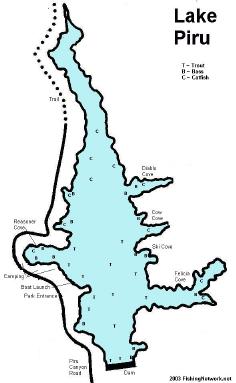Sometimes I feel a little crazy as a fisherman. I mean who goes out on a lake fishing when it's freezing and raining? Awesome anglers that's who! I had these images on my camera from when I went out the weekend before a tournament at Lopez Lake to do a little pre-fishing and had some success so I decided to share. This trip was in early to mid February and the weather had been pretty brutal. I think air temps were in the 40's-50's along with some serious rain. If you have the proper equipment and gear (rain suit and boots) it's really not that bad. If you like solitude on the lake then this is your favorite time to be on the water. I mean look at the boat ramp, it's just me:)
 |
| The one and only angler on the lake. |
Something to consider is the temperature of the water and if the lake is turned over or not. In the winter time at some point the temperature towards the surface becomes cooler and denser (aka heavier) and sinks taking a lot of oxygen down with it. During this time the lake stratifies or develops layers. A thermocline separates the two or three major layers of water. The thermocline is the area where greatest change in temperature with depth occurs. Below are a couple of articles that talk about the thermocline:
Simply put, the thermocline is a thin layer of water in a lake which is sandwiched between the upper layer of water (the epilimnion) and the lower, colder layer of water (hypolimnion). During the summer months, surface water is heated by the sun and the surface temp could be 80 degrees or more. This floats over a layer of colder more denser water called the hypolimnion. Now, between these 2 layers you have a thin layer in which the water temp drops substantially. This will be the thermocline. The temp at this level may be high 60's and up in about the middle of spring.
 |
| Graph for ocean of depth vs.temperature. Reference site. |
The temperature in a lake is seldom the same from the surface to the bottom. Usually there is a warm layer of water and a cooler layer. Where these layers meet is called a thermocline. The depth and thickness of the thermocline can vary with the season or time of day. In deep lakes there may be two or more thermoclines. This is important because many species of game fish like to suspend in, just above, or just below the thermocline. Many times baitfish will be above the thermocline while larger game fish will suspend in or just below it. Fortunately, this difference in temperatures can be seen on the sonar screen. The greater the temperature differential, the denser the thermocline shows on the screen.
During the late winter there is usually no stratification on most lakes. As a result the water will undergo a temporary oxygenation process. Strong winds, feeder streams feed the lake with spring rains and plant growth begins. So under normal conditions the deeper end of a water body will be quite saturated with oxygen. Since the lower layer is much colder than the surface (averages 10 to 25 degrees difference) the deeper portions can retain the oxygen molecules sent its way during the pre-stratification.
Why does the hypolimnion lose it's oxygen? The thermocline and the upper layer of water are continually replenishing their oxygen supply and the hypolimnion gradually loses it for several reasons.Probably the most important reason is there is very little or no plant life beyond the 30 foot level. Unless the water is gin clear the suns rays cannot penetrate the lake deep enough to grow any vegetation.Key points from this reading:
- Lake turns over in Fall (October, November) when cool water on the bottom is pushed up by the even colder more dense water on the surface (caused by dropping air temperatures).
- Fish will be deep (hypolimnion) when oxygen levels are greater there then near the surface (usually winter). Also known as the pre-stratification period.
- When the lake becomes stratified or layered (thermocline developed and seen on sonar) most bass will be found in the thermocline because it is most comfortable for them (not too much light and more oxygen then hypolimnion). This is usually late winter early spring.
The bass below was caught on a rip-bait, a 4 in. River to Sea bait to be exact. I was fishing the inside of secondary points on steep angled banks targeting suspending fish. An interesting thing happened during this outing that is worth taking note. I caught my first fish after I got a backlash and was messing with the line. The lure was out there and down to its running depth of about 8 feet. While I was messing with the line the bait was suspended and not moving at all for probably close to 30 seconds and that's when the fish hit! This told me I needed to really slow down! I caught 2 fish in 3 hours and developed a good pattern because both these fish weighted more than three pounds.
The only problem was the next week the weather totally changed on me! The front passed and there was high pressure and clear blue bird sky's. I was able to catch two keepers but my original plan fell through and I had to scramble to catch those two. I forget what the winner caught them on but I think the bass were not suspending but were relating more to the bottom.
 |
| Makes the trip worth wile. Three pound late winter bass! |


























